Crispy on the outside and soft on the inside, Kuttu ki Puri is a classic Indian flatbread often prepared during sacred Hindu fasts and festivals such as Navratri, Ekadashi, Mahashivratri, and Janmashtami. This deep-fried delicacy is not just a festive treat but also a comforting dish enjoyed across many North Indian homes during vrat (fasting) days. What makes this puri truly special is its earthy flavor and satisfying texture that pair wonderfully with a variety of vrat-friendly curries and side dishes.
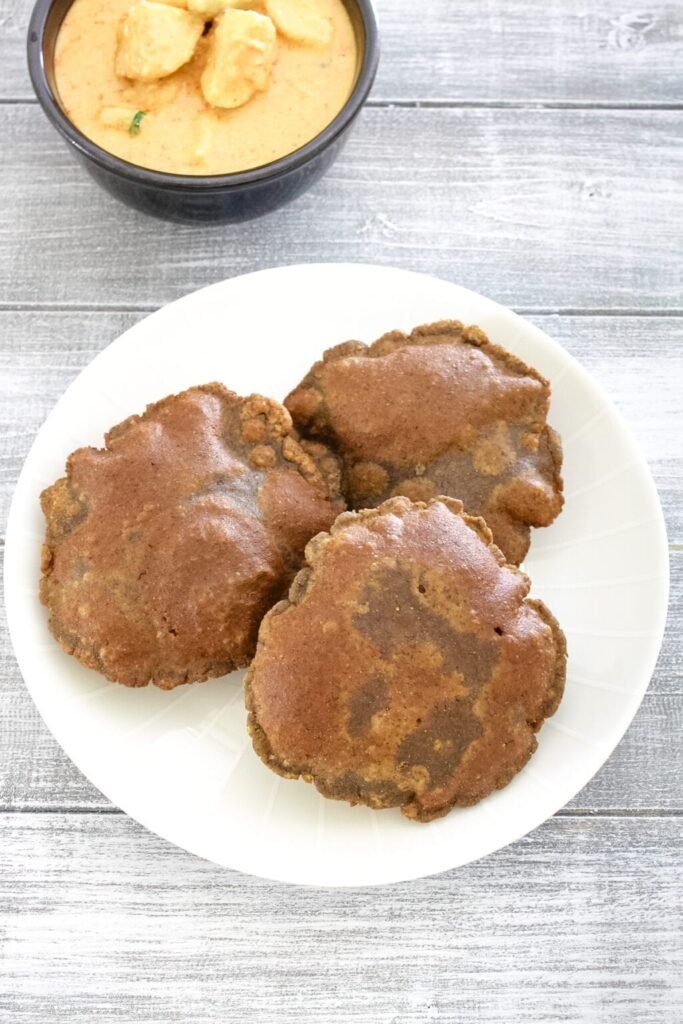
At the heart of this recipe lies Kuttu ka Atta, which is the Hindi term for Buckwheat Flour. Although the name might suggest otherwise, buckwheat is not related to wheat. It belongs to a group of foods called pseudo-cereals, which are seeds used like grains but do not contain gluten, making buckwheat flour a naturally gluten-free alternative.
Rich in fiber, high-quality protein, and essential minerals like magnesium and iron, buckwheat flour is not only a healthy alternative but also completely gluten-free and vegan. This makes Kuttu ki Puri a nutritious option for those following a gluten-free diet or looking to include more plant-based foods during their fast.
When deep-fried, the puris puff up beautifully and develop a delightful crispness on the outside, while the inside remains soft and slightly chewy. The mildly nutty taste of buckwheat flour, enhanced by a touch of rock salt (sendha namak) and mashed potatoes for binding, gives the puris a distinctive flavor profile that makes them a favorite even outside the fasting period.
Whether you’re observing a religious fast or simply want to enjoy a wholesome, gluten-free Indian bread, Kuttu ki Puri is a delicious way to nourish the body while honoring traditional dietary practices. Serve it hot with vrat-friendly aloo sabzi, curd, or a cucumber peanut raita, and enjoy a soulful meal that’s both comforting and festive.
About This Kuttu Ki Puri Recipe
People actively choose kuttu ka atta (buckwheat flour) during Hindu fasting rituals or vrat, along with flours like rajgira atta (amaranth flour), singhare ka atta (water chestnut flour), and arrowroot flour. They consider these flours satvik—pure, light, and easy to digest—making them perfect for religious fasts. During festivals like Navratri, many prepare Kuttu ki Puri using buckwheat flour, as it stands out as one of the most loved and flavorful vrat-friendly dishes.
While buckwheat flour is gluten-free, it still holds up well in cooking and is surprisingly easy to handle. When mixed with mashed potatoes or colocasia (arbi), the dough binds nicely and can be rolled into puris without much cracking or breaking. This makes it an ideal substitute for wheat-based puris during vrat, without compromising on texture or taste.
Since buckwheat generates heat in the body, people often pair it with cooling dishes like curd-based curries to balance its warming nature. Serving Kuttu ki Puri with a yogurt-based curry not only enhances the flavor but also supports digestion during fasting. In this recipe, we pair it with Dahi Arbi—a mildly spiced yogurt and colocasia curry that complements the puri’s nutty flavor and brings a comforting, cooling element to your vrat meal.
So if you’re looking for a wholesome, satisfying dish during your fast, Kuttu ki Puri with a cooling yogurt side is both nourishing and in line with traditional fasting guidelines.
Ingredient Notes:
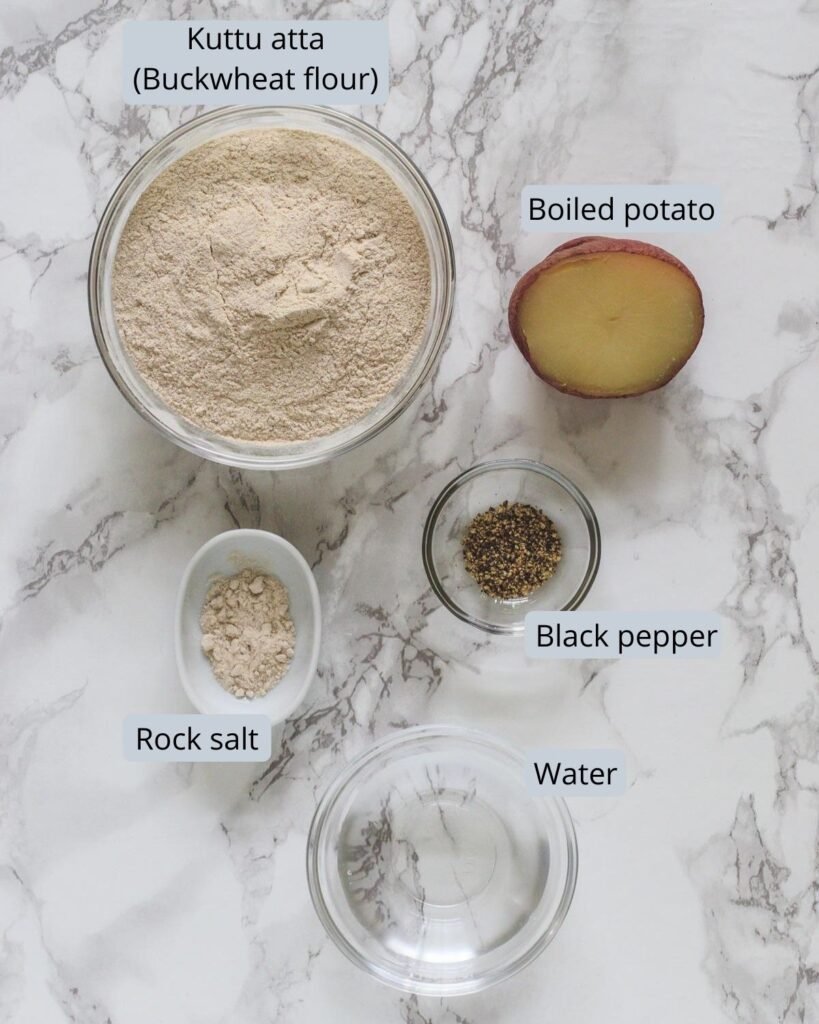
- Boiled and Mashed Potato: The addition of boiled potatoes is key when working with gluten-free flours like buckwheat. Mashed potatoes act as a natural binder, helping hold the dough together and making it easy to roll without cracking. They also contribute to making the puris soft on the inside while ensuring a pleasant, well-rounded texture. Besides functionality, potatoes add mild flavor and a bit of heartiness to the puris, making them more filling.
- Buckwheat Flour (Kuttu ka Atta): Buckwheat flour, or kuttu ka atta, is the core ingredient in this recipe. Rich in fiber, protein, and antioxidants, it’s commonly used during fasting due to its sattvic nature. With a mild, nutty flavor, it adds depth to the puris. Though gluten-free, it mixes well with mashed potatoes to form a soft, easy-to-roll dough.
- Black Pepper Powder (Optional): Though optional, a light sprinkle of black pepper can enhance the flavor without overwhelming the taste. It’s one of the few spices permitted during fasting and also offers warmth and digestive benefits.
- Rock Salt (Sendha Namak): Regular iodized salt is avoided during vrat. Instead, sendha namak, or rock salt, is used. It is considered pure, unprocessed, and acceptable in fasting diets. It provides a subtle saltiness without altering the spiritual intent of the meal.
- Water: A small quantity of water is added as needed to bring the dough together. Use it gradually to ensure the dough stays firm yet pliable.
- Plus Oil for Deep Frying: Use any fasting-approved oil like ghee or peanut oil to deep-fry the puris until they puff up and turn crisp and golden.
How To Make Kuttu Ki Puri?
1) Combine dry ingredients:
Place buckwheat flour (kuttu ka atta) in a mixing bowl, add a bit of sendha namak (rock salt), and include a dash of black pepper powder if you prefer a hint of spice. These ingredients form the base flavor of the puris.
2) Add mashed potatoes:
Next, add boiled and mashed potatoes to the flour mixture. Potato works as a natural binder, helping to hold the dough together, since buckwheat flour doesn’t contain gluten, the element that usually gives dough its stretch and structure.
3) Mix using fingertips:
Gently mix the mashed potatoes into the flour using your fingertips, and rub them together until you create a crumbly, even texture. Make sure you remove any large lumps of potato.
4) Knead into a dough:
Slowly add warm water in small amounts and begin kneading the mixture to bring the dough together. Continue until you get a medium-soft dough that is neither sticky nor too firm. Cover the dough with a damp cloth or lid and let it rest for about 15 minutes. This resting period helps the dough hydrate and become smoother.
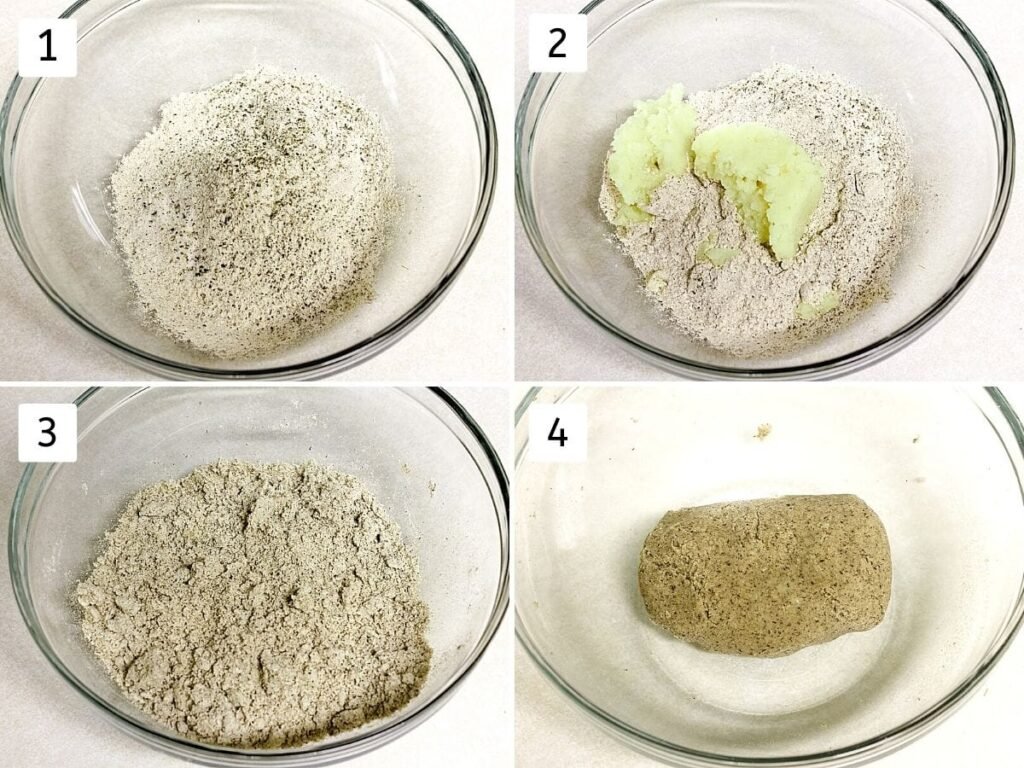
5) Divide and shape:
Once rested, knead the dough again briefly to make it smooth. Divide the dough into 7 equal portions. Roll each into a smooth ball, then gently flatten each one between your palms to prepare for rolling.
6) Roll into circles:
Dust a rolling surface or parchment lightly with buckwheat flour. Take one flattened dough piece and roll it out into a 3-inch diameter circle. Handle gently, as gluten-free dough can be delicate.
7) Heat oil and fry:
Warm up vrat-friendly oil like ghee or peanut oil in a deep pan over medium flame. As the oil heats, roll out a few more puris and set them aside. Once the oil reaches the right temperature, carefully place one puri into the hot oil. Use a spatula to lightly press it in a circular motion so it puffs up nicely.
8) Flip and finish frying:
After the puri has puffed, flip it carefully and cook the other side until golden and crisp. Remove it with a slotted spoon and place it on a plate lined with paper towels to absorb excess oil. Repeat the frying process for the remaining puris.
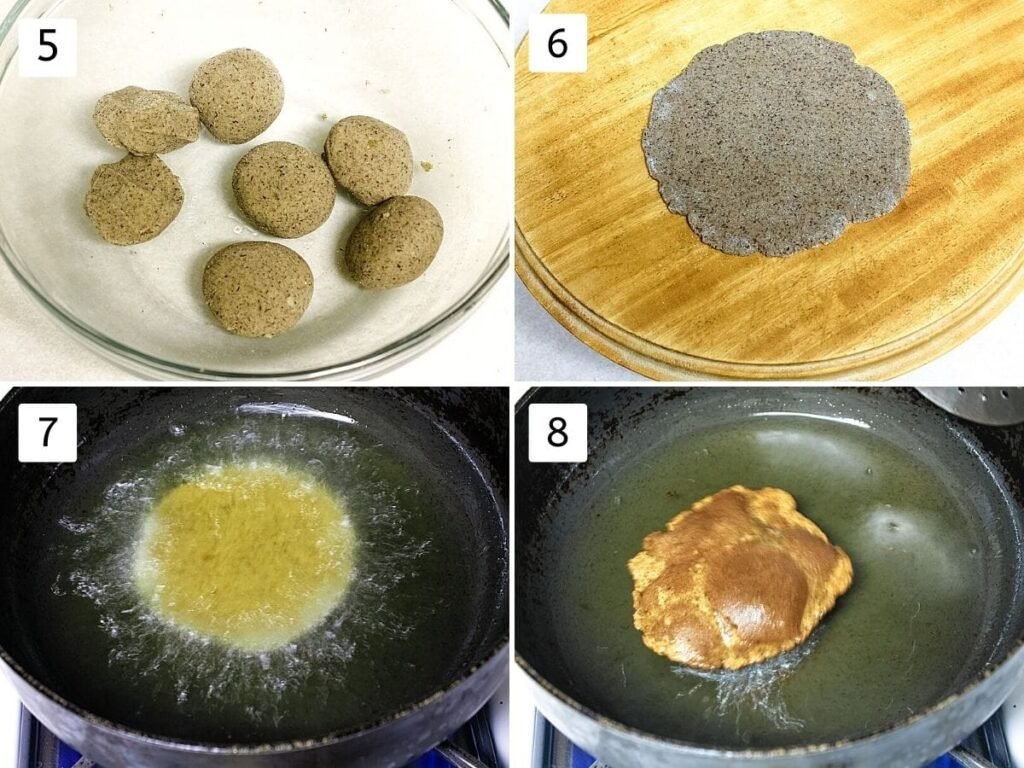
Expert Tips for Perfect Kuttu ki Puri:
1) Color of the Puris:
The shade of your puris can differ based on the variety and brand of buckwheat flour used, as some flours are naturally darker while others are lighter in color. Some flours are naturally darker with a deeper brown tone, while others appear lighter and more beige. This variation is completely normal and doesn’t affect the taste or quality of the puris.
2) Mash the Potatoes Thoroughly:
Mash the boiled potatoes until they are completely smooth. Even small chunks or leftover bits can prevent the puris from puffing evenly or cause them to break while frying. A smooth, lump-free mash helps you form a cohesive dough and ensures the puris puff up uniformly.
3) Maintain Even Thickness:
While rolling, aim for a uniform thickness across the entire puri. Uneven rolling can lead to flat spots, preventing the puri from puffing up properly. Keep the puris medium thick—not too thin (they may turn crispy) and not too thick (they may remain uncooked from inside).
4) Check Oil Temperature Before Frying:
Heat the oil well before frying. If the oil is not hot enough, the puris will absorb more oil due to the presence of mashed potatoes and may become greasy. Also, they may remain flat instead of puffing up.
5) How to Test Oil Readiness:
To check if the oil is ready, drop a small piece of dough into the oil.
- It sinks and rises slowly; the oil is not hot enough.
- When the dough piece floats up gradually and steadily, it shows you have heated the oil to the right temperature for frying.
- If it shoots to the surface instantly and browns too fast, the oil is overheated—reduce the flame slightly before continuing.
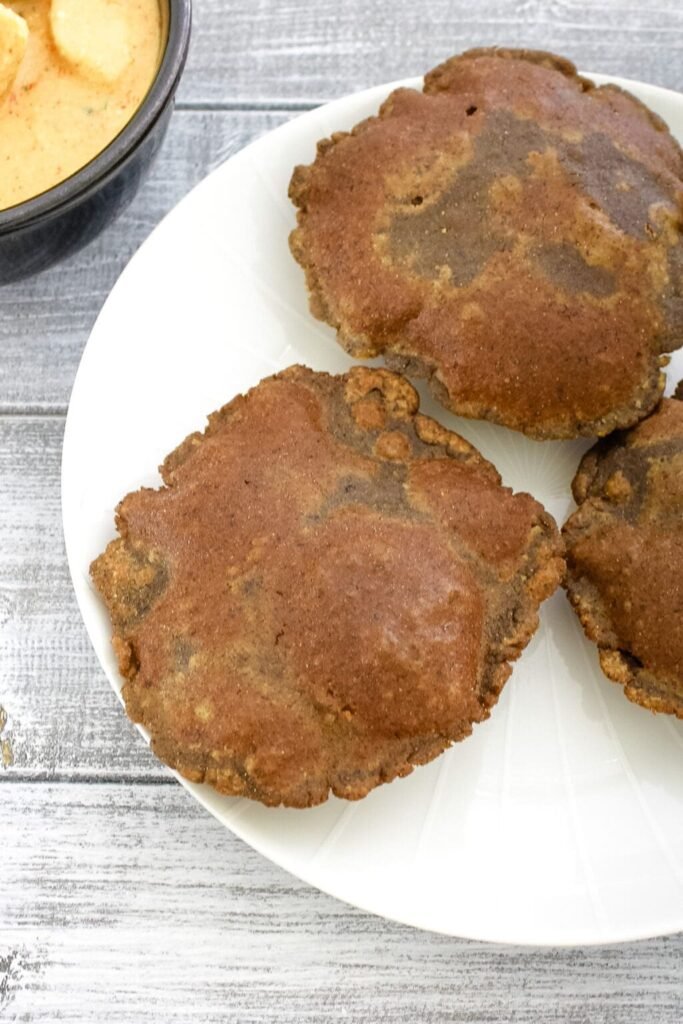
Serving Ideas:
1) Pair with Dahi Arbi, Suran Sabzi, or Dahi Aloo:
Kuttu ki Puri tastes best when served with mildly spiced, vrat-friendly side dishes. Dahi Arbi (colocasia in yogurt gravy) is a classic choice—cooling, flavorful, and perfect to balance the warmth of buckwheat flour. Another delicious option is to serve it with Suran ki Sabzi (yam curry) or Dahi Aloo—a soothing yogurt and potato-based dish made without the use of onion or garlic, keeping it suitable for fasting. These dishes not only add variety but also keep the meal wholesome and filling.
2) Serve with Farali or Vrat ki Kadhi:
Pair Kuttu ki Puri with Farali Kadhi or Vrat-special Kadhi, and prepare them using curd combined with arrowroot or singhare ka atta. These vrat-friendly curries bring a refreshing, tangy flavor to the plate and beautifully enhance the puris’ taste and texture. Their gentle spices and smooth texture pair well with the nutty, crispy puris.
3) Why Yogurt-Based Dishes are Recommended:
People consider buckwheat flour a warming ingredient, as it raises internal body heat when eaten. To balance this effect, they traditionally pair it with curd-based dishes during fasting. Yogurt has a naturally cooling effect on the body, making it an ideal match to neutralize the warmth of kuttu. This pairing not only delights the taste buds but also promotes easier digestion, which is especially helpful during fasting when meals are simple yet nourishing.
